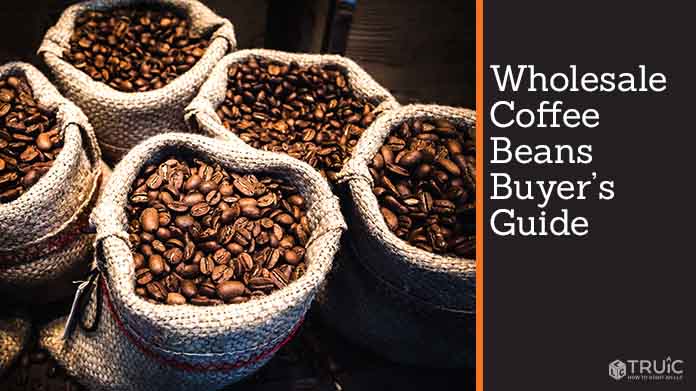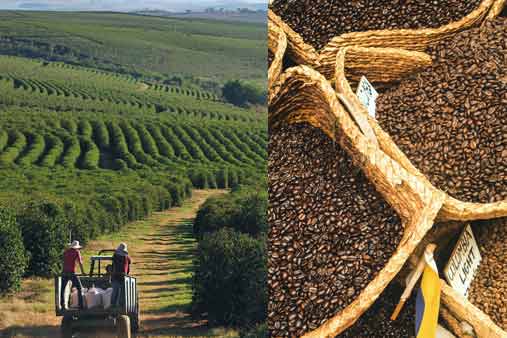Wholesale Coffee Beans Buyer's Guide
With more than 70 countries cultivating coffee plants, buying beans for your specialty coffee shop can seem like a daunting task. There are virtually endless options: 100% organic coffee, fair trade coffee, flavored coffee, just to name a few. You'll also need to find a reliable supplier that fits with your business values, whether its a cooperative of small coffee farms or a third-party importer.
This guide will help you navigate the sourcing process — from how to select which coffees from which regions to feature in your cafe, to determining the type of supplier that will work best for your business.
Recommended: Read our full, in-depth How to Start a Coffee Shop Business guides, inspired by coffee professionals, they will help make your coffee dreams real, from sourcing beans to hiring baristas, choosing the best POS system, forming an actual company, and everything in between.

Prominent Coffee-Growing Countries
Bali
Bolivia
Brazil
Burundi
China
Colombia
Costa Rica
Democratic Republic of Congo
El Salvador
Ethiopia
Flores
Guatemala
Hawaii
Honduras
Step 1: Pick Your Flavor Profile & Target Countries
Your sourcing journey should start with the flavor profile(s) you want to showcase in your coffee shop. For example, do you want to offer an espresso with a fruit-forward flavor profile? If so, then look for blends or single-origin coffees from countries like Ethiopia or Colombia.
It is also important to understand how the method of processing coffee affects the flavor profile. There are three types of processes: natural, washed, or semi-washed/honey. This can differ depending on climate, farmer's choice or tradition for example in Brazil, the natural process is the most commonly used based on climate and tradition.
Recommended: Read our guide for more information on roasting processes
So how does processing impact a coffee’s flavor profile? Here’s a quick overview of the three common processing methods — and their influence on the flavor of the resulting green coffee beans.
- Natural/Unwashed: Once the coffee cherries reach ideal ripeness, farmers pick them from the trees, place them on drying racks, and sun-dry them to fully remove the pulp and mucilage (the fruit surrounding the bean). This typically takes three to six weeks and has been known to produce a brighter flavor profile and fuller body. This process is most commonly used in dry, warm climates with low humidity such as Ethiopia, Brazil, or Yemen.
- Pulped Natural/Honey: Farmers remove the skin of ripe coffee cherries, but leave the sticky mucilage and fleshy inside intact, before sun-drying them as in the natural/unwashed process above. This process, which usually takes about two weeks with nearly constant attention to the beans, produces an overall sweetness and balanced flavor. It’s most commonly used in Costa Rica.
- Fully Washed: After picking ripe coffee cherries, farmers place them in a vat of water and skim off any that float to the top. Farmers then use large amounts of water to remove the pulp and mucilage from the remaining cherries, ferment the cleaned beans or use a machine to wash, and, finally, dry them. This process typically takes about four weeks and allows the coffee to retain the flavor profile inherent to the bean itself vs. adopting a flavor from the processing method. It’s most commonly used in countries with wetter climates, like Kenya, that lack proper weather for sun-drying. However, it’s now increasingly common to see washed coffees in any origin that produces high-quality Arabica beans.
Beyond your preferred flavor profiles and countries, you also should consider several other factors when sourcing coffee beans. These include availability, cost, the business ethics of a specific farm or importer, and even a country’s political climate. In terms of availability, specific regions or farms can experience lulls in production due to the coffee plant’s sensitive nature.
This means you may not always have access to the same variety of coffee beans from a specific supplier. Other potential issues to watch out for when you buy green coffee beans include changing flavor profiles and large quantities of beans that are subpar or do not fit your desired flavor profile.
If you need help branding your coffee business, try using our Free Coffee Shop Logo Maker. Our free tool will help you brand your coffee business with a unique logo to make your small business stand out.
Step 2: Choose Your Supplier
Now that you have a better idea of which coffee beans from which countries match your desired flavor profile, you’re ready to choose a coffee supplier. If you plan to roast your own beans, you have two main supply options — coffee importers and direct-sourcing from farms. Here are some factors to keep in mind as you evaluate the right path for your business:
Importers
- Coffee importers are a common tool in the coffee industry. They are middlemen who source and distribute green (unroasted) coffee beans to roasters.
- The benefit of this approach is greater control and continuity over your product because importers are responsible for designating a profile for each coffee and guaranteeing quality. This is especially helpful because coffee beans vary drastically by lot and season.
- For an importer to transport beans to their facility and then to a buyer, they most likely need to charge at least $4.50 per pound to make a profit.
- Some challenges, however, include lack of a relationship with your farmer as well as higher prices than buying farm direct.
- Check out this comprehensive list of green coffee importers as you evaluate potential importer partners.
Farms
- Sourcing coffee beans directly from a farm is not critical to the success of your cafe. However, many specialty coffee shops maintain a line of contact with the farms from which they buy beans. For some business owners, this can mean regular contact with their supplier farms. For others, it means visiting those farms, bringing them supplies, and developing stronger, personal relationships with individual farmers.
- The necessary price a specialty coffee farmer should charge (just in green bean form) to pay employees a livable wage is around $3.75 per pound.
- The main benefits of this approach include transparency, relationship-building opportunities with your farmer, and lower prices.
- A key challenge, however, involves the actual exporting process. It’s much more difficult than simply shipping beans to your roastery. You’ll need to find an exporter/importer to transport the beans from the producer as well as navigate the taxes and regulations associated with moving coffee across borders. Some producers work with a specific exporter to make this process easier for their buyers.
Step 3: Sample Before Buying
Whether you decide to work with a coffee importer or a farm, sampling your potential partners’ products before you buy is a critical part of the sourcing process. The industry standard for sampling coffees is known as “cupping,” which involves assessing coffee samples using sight, smell, and taste.
Here’s how it works:
- Request samples of each coffee you want to test from potential suppliers.
- The importers and/or farms send you 250 to 500 grams of each requested coffee.
- Samples from importers may arrive ready to grind or as green beans that you must lightly roast before testing.
- Samples from farms usually arrive as green beans.
- Roast your samples, as appropriate, maintaining a consistent roast level across each coffee so you can accurately compare them all.
- Follow the "cupping" process to assess each sample. You will need your roasted coffee samples, water, a kettle, glass cups (five for each coffee sample), trays (for whole bean coffee), tasting spoons, and one bowl of water for each type of coffee. Be sure to maintain continuity for all amounts of coffee, water temperature and volume, glass cup size, grind, and extraction time during the “cupping” process.
- Prepare the “cupping” area
- Smell the dry coffee
- Fill the drinking vessels
- Break the crust
- Scrape the crust
- Taste the coffee
- Taste the coffee twice more
Recommended: Read our full How to Cup Coffee guide for more detail on each step of this process.
Step 4: Know the Fair Price
How much should you expect to pay for quality beans? Before you buy, here are some general rules for fair coffee prices:
- The price a specialty coffee farmer should charge you (just in green bean form) to pay their employees a livable wage is around $3.75 per pound.
- For a coffee importer to transport beans to their facility and then to you, they most likely need to charge at least $4.50 per pound to make a profit.
- You should expect to pay the above prices per pound for your coffee beans as well as additional fees for labor (e.g., for roasting and preparation if you roast your own coffee), packaging, energy, and equipment. You can, however, reduce your equipment costs by using a shared roasting space.
Step 5: Buy Your Beans
If you still plan to roast your own beans, work with your preferred coffee importer or farm supplier to purchase and ship your favorite beans based on your “cupping” results.
On the other hand, if roasting beans is not part of your business plan, you can buy coffee fairly easily and cost-efficiently from a wholesale roaster. One major benefit of this approach is that you can feature different roasters and offer customers more variety because you don’t have to worry about selling a large amount of one specific type of coffee.
If you opt to buy coffee from a wholesale roaster, choosing the right one for your business will depend largely on taste and accessibility. For example, if you don’t have local access to the type of coffee you want to sell, you’ll need to factor in the added cost and time to ship coffee from a roaster in another city or state. You also may want to consider whether a wholesale account with a roaster includes any training and/or equipment, which can help offset the cost of buying vs. roasting your coffee.
Here are a few things to look for when buying your beans wholesale:
- Roast Types: Do they specialize in light, medium, dark, or a mix of all three?
- Blends and Single Origins: What variety do they offer in terms of blends vs. single-origin coffees? What beans do each of their blends include?
- Origins: Which specific origins do they carry regularly? How frequently do they feature coffees from other origins, and are these available for wholesale?
- Terms of Wholesale: Do they require you to use one specific coffee for espresso? Are there any restrictions or different options for wholesale buyers?
- Additional Perks: What perks do they offer their wholesale account holders? Do they include any training and/or equipment?
- Pricing: What pricing or discounts do they offer wholesale customers?
- Order Timeline: Due to the sensitive nature of coffee, your timeline for ordering wholesale coffee is crucial to ensuring a high-quality, flavorful product. Most wholesale roasters provide guidelines for storing and ordering their coffee. In general, plan to use whole bean coffees within a week of delivery and espresso within 12 weeks of its roasting date.
Recommended: Still debating whether or not to roast your own coffee? Check out our article on the pros and cons of roasting for coffee shops, written by coffee professionals this guide will help you understand the process of roasting and sourcing coffees.


